
Recently on Cyclingnews.com |
|
|
View from the lab - Ric Stern's Tour de France sports science
British ABCC coach Ric Stern (www.cyclecoach.com) is a regular contributor to Cyclingnews' Form & Fitness section along with being a full time coach. Still an active rider when time allows, Ric will be providing a physiological insight into the challenges that face the riders in the Tour.
July 13: Stage 11 - Big efforts uphill
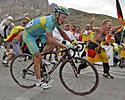
|
Stage 11 was the second day in the Alps, with three brutal climbs - the Col de la Madeleine, Col du Telegraphe and the monster that is the Col du Galibier. The Galibier is an astonishingly high 2645 vertical metres and is the highest climb of the 2005 Tour by a large margin.
With Alexandre Vinokourov and Santiago Botero being away for the majority of the day (albeit with other riders earlier on) it would have been a treacherously hard day for these two. They'd have had little chance to recover and would've had to work hard for the majority of the day. The advantage of being in a largish peloton (such as the group maillot jaune) is that Lance Armstrong would've been able to set his troops to work at a high effort to keep the escapees in check. With the Discovery boys taking turns on the front and setting a high tempo, the domestiques could afford to burn themselves out while protecting Lance, and keeping the group a respectable and close distance behind the leaders.
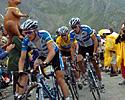
|
Even though this is the mountains, there's still an awful lot of shelter to be had behind the leading riders. Yesterday we saw that the approximate average velocity on the last climb for the Armstrong group was a shade over 25 km/h. On the Madeleine it appears (with a quick calculation) that the group maillot jaune crested the mountain in 63 minutes for the 25 km. That's an average velocity of 24.1 km/h (requiring about 400W for someone of about 73 kg). As expected, the Armstrong group was taking it relatively easy compared to yesterday's summit finish (at least for the big guns).
With such a relatively high velocity on the climb there is still a lot of air drag to overcome and drafting helps to reduce this (therefore, those sitting behind the pacemakers of a group are working less than if they were on the front). At a velocity of about 25 km/hr (on level ground) around 75% of the power generated to provide forward movement is used to overcome air drag. On a climb like today, obviously gravity plays a huge part, but so does air drag as well. Interestingly, at these speeds deep-dish carbon aero rims are likely to be an advantage over lighter box section rims.
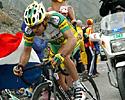
|
Going back to Vinokourov and Botero; they would have had to work harder up the climb to get the gap, work more on the descent to increase the gap and would have had to red line it up the last climb to maintain the gap they had so valiantly worked for. And even then the gap was reduced by more than half on the final descent to Briancon. Going up the Galibier it's likely that Vino and Botero would have been riding at their maximum sustainable effort - around zone 4 to zone 5, depending on how they paced it.
Physiologically speaking, what makes a good climber? The attributes of a good climber will include a high lactate threshold, a high VO2max (and high MAP), and most likely a low to moderate body mass (obvious exception to this was 'big' Mig Indurain in the 90's who was about 81 kg).
While there's a couple of definitions of lactate threshold (none of which are about a one-hour TT effort), they are however all highly correlated with the effort that can be sustained maximally for around one hour (LT is actually lower than this by around 10 - 15%). The ability to sustain a high effort TT effort is important. However, it is also vital to have a high maximal aerobic power (MAP). Cyclists can in general sustain about 72-77% of MAP for about 1-hr. However, if your MAP isn't high enough then it doesn't matter what percentage you can sustain of it - it won't be good enough. In other words if you want to be a pro cyclist a high MAP and LT are crucial.
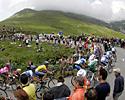
|
While it is true that pro cyclists are born (they chose their parents better than the rest of us who wanted to make it as pros but couldn't) both pro cyclists and the average cyclist/racer, sportif rider, or those interested in better fitness can increase their LT (and TT power) and MAP. Two crucial sessions for increasing these extremely important aspects of performance are:
1) TT Booster: one to four intervals of 15 to 30 minutes at about a one-hour TT intensity, repeated one to three times per week (depending on fitness and where you are in your training progression). To add a skill element to it, those who mainly do TTs should do this session on their TT bikes, while those who are looking to improve their climbing ability should do this uphill.
2) MAP booster: three to eight intervals of 3-5 minutes at about 80-90 % of MAP, repeated one to three times per week, with a 1:1 work:rest interval. Again, these can be done on TT bike, road bike, and uphill for varying skill elements
Prior to attempting these intervals you should be physically fit, not ill, have no underlying illness or diseases and should have been training regularly for six months. You should always check with a medical doctor prior to beginning any training programme. These sessions are very intense.
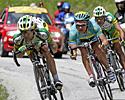
|
Going back to the stage, we can see that Vino and Botero crested the giant Galibier in front of the maillot jaune group. On the way down we saw that Vino either waited for Botero to come back to him or simply didn't have the necessary skill required going downhill at high speed. Several years ago (1997 off the top of my head) we saw a similar thing with Ullrich, who kept overcooking the corners. It's imperative that not only do you or the pros have as high a fitness level as is possible, but that you also have the necessary skills required to descend or corner at speed...it's no good being first up the hill, if everyone passes you on the descent.
As I look at tomorrow's route profile, there are some nasty hills involved and I think a few GC riders will either attack (Vinokourov again?) maybe a group of lowly placed riders go on a long breakaway.
2005 entries - the Tour de France
- July 28 - Stage 21 - What it takes
- July 23 - Stage 20 - Getting the TT right - and wrong
- July 22 - Stage 19 - The perfect break
- July 21 - Stage 18 - High intensity and fatigue
- July 19 - Stage 16 - Maintaining an attack
- July 17 - Stage 15 - Tour's biggest day
- July 16 - Stage 14 - Attacks keep coming
- July 15 - Stage 13 - Positive thoughts
- July 14 - Stage 12 - Hot, hot, hot!
- July 13 - Stage 11 - Big efforts uphill
- July 12 - Stage 10 - Number crunching
- July 7 - Stage 6: The dynamics of a breakaway
- July 6 - Stage 5: Coming back after a TT
- July 5 - The TTT - Man, machine and team
Previous Cyclingnews features by Ric Stern
- Winter Training
- Weight training and cycling - The Great Debate
- Power zone training - How to set training levels with a power meter
- Ric Stern also answers Cyclingnews readers' questions in our Form & Fitness Q&A section

